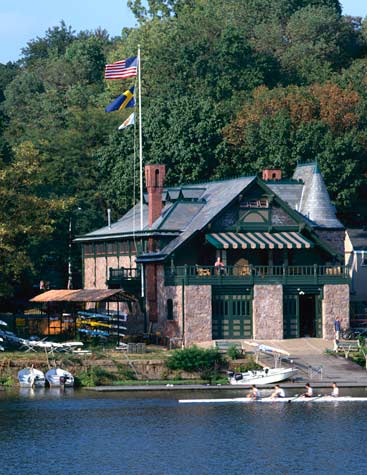There are larger and more flamboyant buildings by Frank Furness, but few better exemplify his original ideas that are the root of modern architecture than his design for the Undine Barge Club Boathouse. Working in Philadelphia, Furness was able to apply what are essentially modern principles to the shaping of architectural form.

In Undine’s Boathouse, Furness demonstrated that he had learned to sculpt mass to express function. The castle-like tower no doubt refers to the setting of the Undine myth so it too, had a function, albeit a symbolic one.
After more than a century of use, the Boathouse survives with a remarkable degree of integrity. In recent years, Undine Barge Club members have funded major repairs to the interior of the house. It became apparent, however, that major exterior and interior restoration-work was overdue.
In 1996, the Club commissioned George E. Thomas, PhD, a Furness expert, to prepare a preservation report for the Boathouse. His work became a foundation for developing a restoration plan for the historic Boathouse.
The Club continued its restoration efforts by selecting the Hillier group, an architectural firm of national prominence. Building on Thomas’ work, the plan aimed to restore the original Furness qualities to this important structure, while continuing its usefulness as a rowing club of national prominence.
A generous grant from the William B. Dietrich Foundation provided funding to launch the exterior restoration work in 1997. The external restoration was completed and the Boathouse was rededicated in July 1999.
– – –
Designed in 1882, the Boathouse’s first pilings were driven on April 3, 1882, and its cornerstone was laid April 24, 1882. The building was “under roof” by autumn, and the first row from the new Boathouse took place on October 29, 1882. Completed in the spring of 1883 at a total cost of $14,000, the Boathouse was formally opened that summer.
Characterized as “a celebration in stone and wood of athletic endeavor and fellowship”, the Boathouse exemplifies the courage, the confidence and the vitality of “Furnessque” design. The bold shapes, scales and individualism of Furness’ work are perhaps nowhere more apparent than here, along Boathouse Row, where the unique character of the Undine Boathouse stands prominently apart from the more conventional.
Read more about the history of Undine and of Boathouse Row in the Encyclopedia of Greater Philadelphia, provided online by the the Mid-Atlantic Regional Center for the Humanities (MARCH) at Rutgers-Camden.